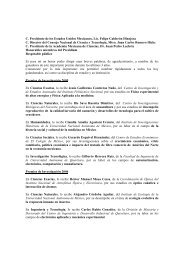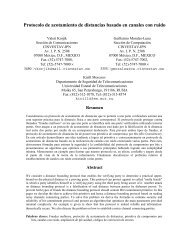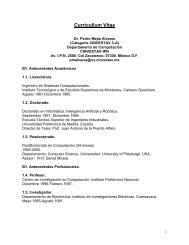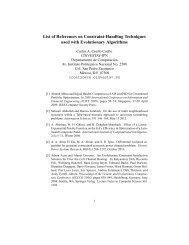- Page 1 and 2: CENTRO DE INVESTIGACIÓN Y DE ESTUD
- Page 3 and 4: II ÍNDICE GENERAL 2.2.1. Estrategi
- Page 5 and 6: IV ÍNDICE GENERAL 6.2.1. Recolecto
- Page 7 and 8: Índice de figuras 2.1. Ambiente de
- Page 9 and 10: VIII ÍNDICE DE FIGURAS 7.27. Proce
- Page 11: X ÍNDICE DE TABLAS 4.7. Fragmentos
- Page 14 and 15: GLOSARIO DE SIGLAS XIII CAT Cluster
- Page 16 and 17: GLOSARIO DE SIGLAS XV TC Transporta
- Page 18 and 19: Resumen Una de las actividades más
- Page 22 and 23: ABSTRACT XXI partitioning in multim
- Page 24 and 25: Capítulo 1 Introducción La consta
- Page 26 and 27: como libros, periódicos, revistas,
- Page 28 and 29: 1.2. Diseño de bases de datos dist
- Page 30 and 31: 1.2. Diseño de bases de datos dist
- Page 32 and 33: 1.2. Diseño de bases de datos dist
- Page 34 and 35: 1.3. Motivación 11 el esquema se d
- Page 36 and 37: 1.5. Organización de la tesis 13 U
- Page 38 and 39: 2.1. Conceptos de bases de datos di
- Page 40 and 41: 2.1. Conceptos de bases de datos di
- Page 42 and 43: 2.1. Conceptos de bases de datos di
- Page 44 and 45: 2.1. Conceptos de bases de datos di
- Page 46 and 47: 2.1. Conceptos de bases de datos di
- Page 48 and 49: 2.1. Conceptos de bases de datos di
- Page 50 and 51: 2.1. Conceptos de bases de datos di
- Page 52 and 53: 2.1. Conceptos de bases de datos di
- Page 54 and 55: 2.1. Conceptos de bases de datos di
- Page 56 and 57: 2.1. Conceptos de bases de datos di
- Page 58 and 59: 2.1. Conceptos de bases de datos di
- Page 60 and 61: 2.2. Diseño de bases de datos dist
- Page 62 and 63: 2.2. Diseño de bases de datos dist
- Page 64 and 65: 2.2. Diseño de bases de datos dist
- Page 66 and 67: 2.2. Diseño de bases de datos dist
- Page 68 and 69: 2.2. Diseño de bases de datos dist
- Page 70 and 71:
2.2. Diseño de bases de datos dist
- Page 72 and 73:
2.3. Procesamiento de consultas 49
- Page 74 and 75:
2.3. Procesamiento de consultas 51
- Page 76 and 77:
2.3. Procesamiento de consultas 53
- Page 78 and 79:
2.3. Procesamiento de consultas 55
- Page 80 and 81:
2.4. Comentarios 57 Se explicaron l
- Page 82 and 83:
3.1. Fragmentación estática en ba
- Page 84 and 85:
3.1. Fragmentación estática en ba
- Page 86 and 87:
3.1. Fragmentación estática en ba
- Page 88 and 89:
3.1. Fragmentación estática en ba
- Page 90 and 91:
3.1. Fragmentación estática en ba
- Page 92 and 93:
3.1. Fragmentación estática en ba
- Page 94 and 95:
3.1. Fragmentación estática en ba
- Page 96 and 97:
3.1. Fragmentación estática en ba
- Page 98 and 99:
3.1. Fragmentación estática en ba
- Page 100 and 101:
3.1. Fragmentación estática en ba
- Page 102 and 103:
3.1. Fragmentación estática en ba
- Page 104 and 105:
3.1. Fragmentación estática en ba
- Page 106 and 107:
3.1. Fragmentación estática en ba
- Page 108 and 109:
3.1. Fragmentación estática en ba
- Page 110 and 111:
3.1. Fragmentación estática en ba
- Page 112 and 113:
3.1. Fragmentación estática en ba
- Page 114 and 115:
3.1. Fragmentación estática en ba
- Page 116 and 117:
3.1. Fragmentación estática en ba
- Page 118 and 119:
3.1. Fragmentación estática en ba
- Page 120 and 121:
3.2. Fragmentación estática en ba
- Page 122 and 123:
3.2. Fragmentación estática en ba
- Page 124 and 125:
3.3. Fragmentación dinámica en ba
- Page 126 and 127:
Capítulo 4 MAVP: Fragmentación Ve
- Page 128 and 129:
4.2. Motivación 105 q1:Encuentra t
- Page 130 and 131:
4.3. Árbol de partición 107 Figur
- Page 132 and 133:
4.4. Beneficio de fusión de MAVP 1
- Page 134 and 135:
4.5. Modelo de costo 111 Algoritmo
- Page 136 and 137:
4.5. Modelo de costo 113 Por ejempl
- Page 138 and 139:
4.6. Experimentos y evaluación 115
- Page 140 and 141:
4.6. Experimentos y evaluación 117
- Page 142 and 143:
4.8. Conclusión 119 costo de otras
- Page 144 and 145:
a esta operación de observación d
- Page 146 and 147:
5.1. Reglas activas 123 medio de re
- Page 148 and 149:
5.1. Reglas activas 125 de datos (p
- Page 150 and 151:
5.2. Arquitectura de DYVEP 127 Fase
- Page 152 and 153:
5.2. Arquitectura de DYVEP 129 THEN
- Page 154 and 155:
5.3. Implementación de DYVEP 131 s
- Page 156 and 157:
5.3. Implementación de DYVEP 133 i
- Page 158 and 159:
5.3. Implementación de DYVEP 135 F
- Page 160 and 161:
5.3. Implementación de DYVEP 137 F
- Page 162 and 163:
5.3. Implementación de DYVEP 139 S
- Page 164 and 165:
5.4. Discusión 141 Tabla 5.2: Comp
- Page 166 and 167:
Capítulo 6 DYMOND: Un Sistema Acti
- Page 168 and 169:
6.1. Motivación 145 Algoritmo 6.1
- Page 170 and 171:
6.2. Arquitectura de DYMOND 147 DBA
- Page 172 and 173:
6.2. Arquitectura de DYMOND 149 fra
- Page 174 and 175:
6.2. Arquitectura de DYMOND 151 IF
- Page 176 and 177:
6.2. Arquitectura de DYMOND 153 Reg
- Page 178 and 179:
6.2. Arquitectura de DYMOND 155 Reg
- Page 180 and 181:
6.2. Arquitectura de DYMOND 157 en
- Page 182 and 183:
6.2. Arquitectura de DYMOND 159 act
- Page 184 and 185:
6.2. Arquitectura de DYMOND 161 eve
- Page 186 and 187:
6.4. Conclusión 163 Tabla 6.6: Com
- Page 188 and 189:
7.1. Creación del EFV inicial 165
- Page 190 and 191:
7.1. Creación del EFV inicial 167
- Page 192 and 193:
7.1. Creación del EFV inicial 169
- Page 194 and 195:
7.1. Creación del EFV inicial 171
- Page 196 and 197:
7.1. Creación del EFV inicial 173
- Page 198 and 199:
7.1. Creación del EFV inicial 175
- Page 200 and 201:
7.1. Creación del EFV inicial 177
- Page 202 and 203:
7.2. Proceso de la fragmentación v
- Page 204 and 205:
7.2. Proceso de la fragmentación v
- Page 206 and 207:
7.2. Proceso de la fragmentación v
- Page 208 and 209:
7.2. Proceso de la fragmentación v
- Page 210 and 211:
7.2. Proceso de la fragmentación v
- Page 212 and 213:
7.2. Proceso de la fragmentación v
- Page 214 and 215:
7.2. Proceso de la fragmentación v
- Page 216 and 217:
7.2. Proceso de la fragmentación v
- Page 218 and 219:
7.3. Descripción del esquema DYMON
- Page 220 and 221:
7.4. Descripción de las tablas y d
- Page 222 and 223:
7.4. Descripción de las tablas y d
- Page 224 and 225:
7.5. Conclusión 201 update_flag_pt
- Page 226 and 227:
8.1. Fragmentación vertical estát
- Page 228 and 229:
8.1. Fragmentación vertical estát
- Page 230 and 231:
8.1. Fragmentación vertical estát
- Page 232 and 233:
8.2. Fragmentación vertical dinám
- Page 234 and 235:
8.2. Fragmentación vertical dinám
- Page 236 and 237:
8.2. Fragmentación vertical dinám
- Page 238 and 239:
8.2. Fragmentación vertical dinám
- Page 240 and 241:
8.2. Fragmentación vertical dinám
- Page 242 and 243:
Capítulo 9 Conclusiones En esta se
- Page 244 and 245:
9.1. Conclusiones 221 Una vez se al
- Page 246 and 247:
9.1. Conclusiones 223 asociación e
- Page 248 and 249:
Publicaciones Durante el trabajo de
- Page 250 and 251:
Bibliografía [1] Hector García Mo
- Page 252 and 253:
BIBLIOGRAFÍA 229 [27] Valduriez, P
- Page 254 and 255:
BIBLIOGRAFÍA 231 [56] Ezeife, C.I.
- Page 256 and 257:
BIBLIOGRAFÍA 233 [81] ling Shyu, M
- Page 258 and 259:
BIBLIOGRAFÍA 235 [104] Son, J.H.,











